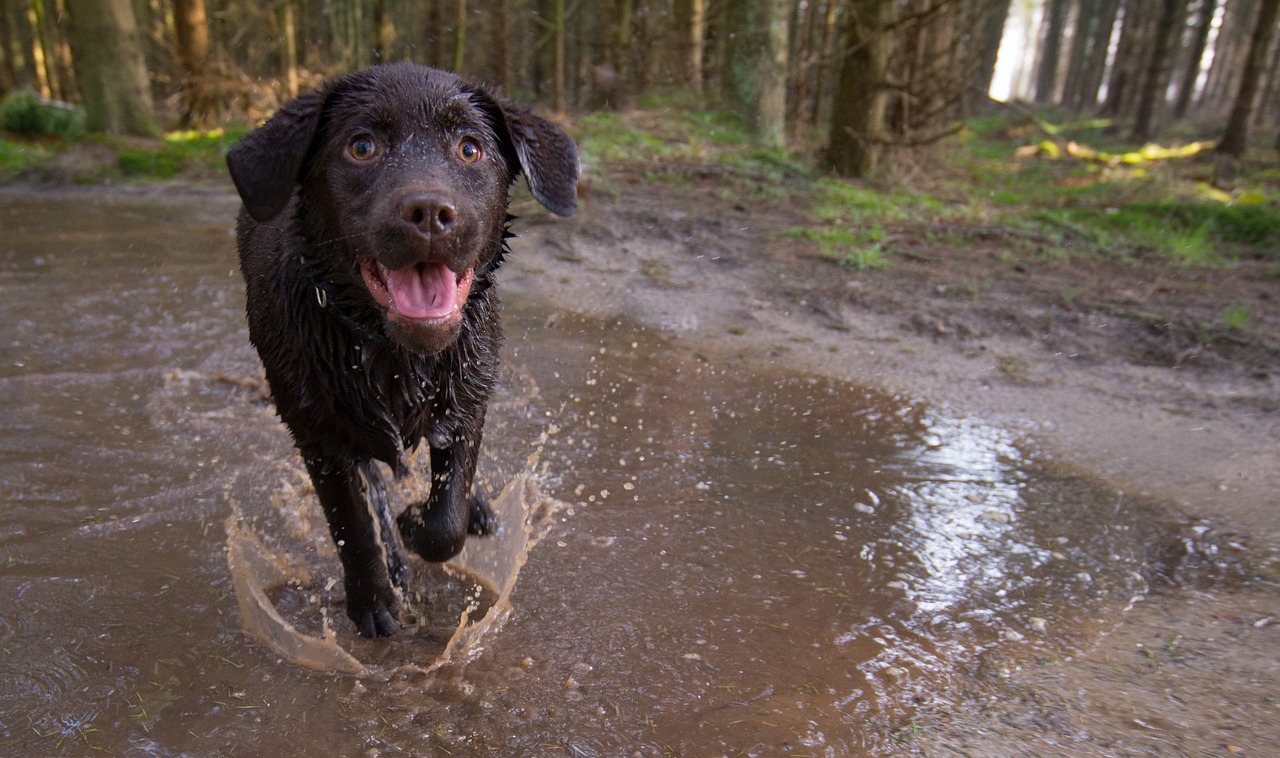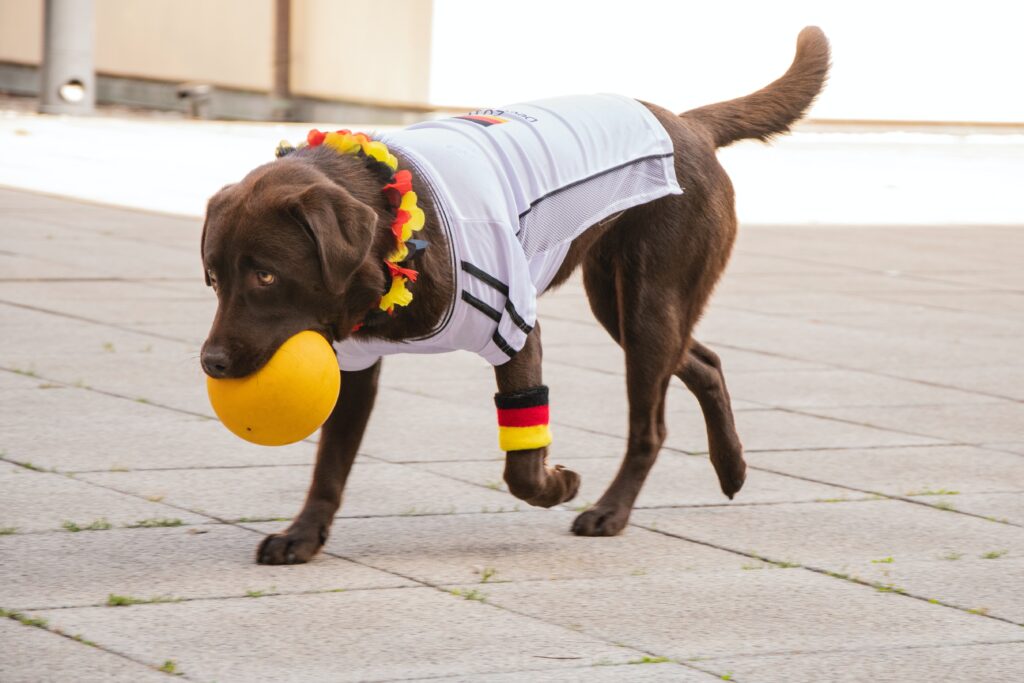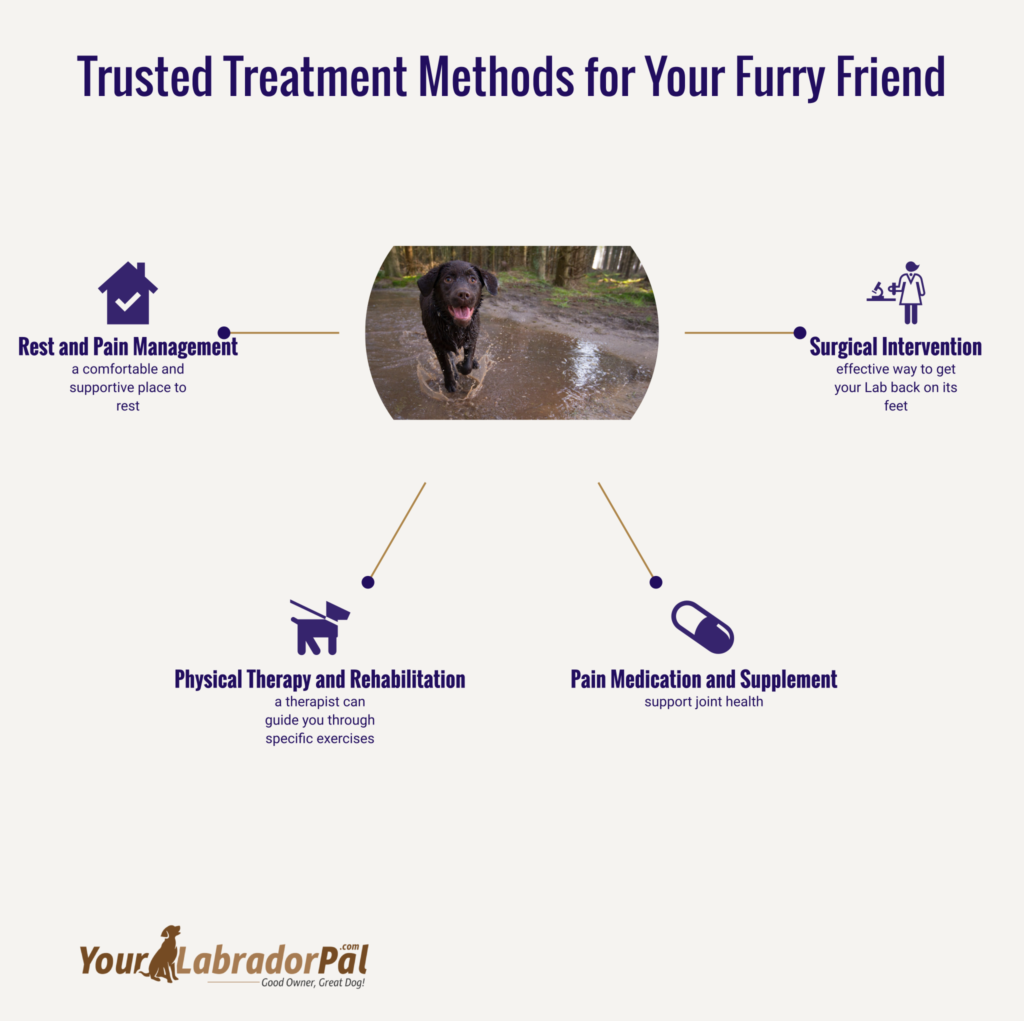Why Is My Labrador Limping?
Have you ever noticed your Labrador suddenly limping and wondered what could be causing it? Why is my Labrador limping, and should I be worried? Labradors are known for their friendly nature, boundless energy, and intelligence, making them one of the most popular dog breeds worldwide. They’re also highly versatile, excelling in roles such as family pets, service dogs, and search and rescue canines. With their active lifestyle, it’s not uncommon for Labradors to experience occasional limping for various reasons.
Addressing your Labrador’s limping is crucial to ensure they remain happy, healthy, and comfortable, but it can be challenging to determine the exact cause. Like humans, dogs may develop various conditions or sustain injuries that can lead to limping.
Sometimes, the reason may be a minor issue that resolves independently, while other instances may require veterinary intervention. As a loving pet owner, understanding the possible causes of your Labrador’s limping and seeking professional advice can help get them back on their paws and enjoy life to the fullest.
So, let’s explore potential reasons behind your furry friend’s limping and how to address them.
Common Causes of Limping in Labradors
Limping in dogs, also known as lameness or an abnormal gait, occurs when a dog experiences difficulty walking or moving due to pain, discomfort, or an underlying medical condition. It can affect one or multiple limbs and may present as a slight limp, an inability to bear weight on the affected limb, or even a complete refusal to walk. Limping can be temporary or persistent, depending on its cause, and may range from mild to severe.
When a dog limps, it is their way of signaling that something is wrong and needs attention. It can result from various issues, such as the following:
🐕 Injuries
One common cause of limping in Labradors is injuries. These energetic dogs love to play and explore, but sometimes their enthusiasm can lead to accidents. Let’s look at some injuries that might cause your furry friend to limp.
-
Sprains and Strains
Like humans, dogs can overextend or twist their muscles and ligaments while running, jumping, or playing. A simple misstep or tumble could result in a sprain or strain, causing your Labrador to limp. Depending on the severity, these injuries can be quite painful and may take some time to heal.
-
Fractures
Although Labradors are sturdy dogs, they aren’t immune to broken bones. Fractures can happen if your dog experiences a significant impact, such as falling from a height or being hit by a car. Sometimes, even rough play with other dogs can lead to fractures. When a bone is fractured, it’s painful and challenging for your dog to move around, causing them to limp.
-
Paw injuries
Lastly, paw injuries are another common reason for limping in Labradors. Our canine companions’ paws are quite sensitive, and they can easily get hurt by stepping on sharp objects like glass, rocks, or thorns.
Even hot pavement, ice, or road salt can cause burns or irritation, making it uncomfortable for your Labrador to walk. Therefore, monitoring your dog’s surroundings and checking their paws regularly for any signs of injury or discomfort is essential.
-
Patellar luxation
Lastly, luxating patella is a relatively common issue in Labradors and other large breeds. It occurs when the patella, or kneecap, slips out of its normal position and causes pain and limping. This condition can be either congenital or acquired due to trauma or an injury, so it’s essential to seek veterinary attention if you notice signs of limping in your Labrador.
🐕 Joint Disease
Another common cause of dog limping is joint issues. As much as we love these playful and energetic dogs, they can be prone to certain joint problems that might cause discomfort and affect their mobility.
-
Hip Dysplasia
This genetic condition affects the hip joint’s development, leading to instability and improper alignment. Over time, this can result in arthritis and pain, making it difficult for your Labrador to move around comfortably. Unfortunately, hip dysplasia is quite common in larger breeds like Labradors, so it’s essential to be aware of this potential issue.
-
Elbow Dysplasia
Next, there’s elbow dysplasia, another genetic condition that affects the development of the elbow joint. Just like hip dysplasia, elbow dysplasia can lead to arthritis and pain over time, causing your Labrador to limp. It’s crucial to keep an eye on your dog’s movement and consult with a veterinarian if you notice any signs of discomfort or limping.
-
Osteoarthritis
Osteoarthritis is another joint problem that can cause limping in Labradors. This degenerative condition occurs when the cartilage in the joints wears down, leading to inflammation, pain, and reduced mobility. Osteoarthritis can develop due to various factors, such as aging, obesity, or previous injuries, and can affect any joint in your dog’s body.
🐕 Infections and Inflammation
Infections and inflammation are also possible causes of sudden limping in Labradors. Since our furry friends don’t always practice good hygiene, they can be prone to various types of infections that might make it uncomfortable for them to move around.
-
Lyme disease
This tick-borne illness is transmitted through the bite of an infected tick. One of the primary symptoms of Lyme disease in dogs is sudden lameness or limping due to joint inflammation and pain. Your Labrador might show discomfort and difficulty moving around due to this condition.
-
Panosteitis
Panosteitis, also known as “growing pains” or “wandering lameness.” This condition affects young, rapidly growing dogs and causes inflammation in the long bones, resulting in pain and limping. Being a large breed, Labradors can be susceptible to panosteitis, which typically resolves on its own as they reach maturity.
-
Septic Arthritis
Another condition to consider is septic arthritis, an infection within the joint. This can be caused by bacteria entering the joint through a wound, surgery, or even spreading from another body part. Septic arthritis leads to inflammation, pain, and swelling, making it difficult for your Labrador to move the affected joint without limping.
🐕 Growth-Related Issues
As a large breed, a Labrador Retriever can sometimes experience certain conditions during their growth and development that may cause discomfort or pain, leading to limping.
One such condition is called growing pains or panosteitis. I mentioned it earlier when we talked about infections and inflammation, but it’s worth bringing up again in the context of growth-related issues.
Another growth-related issue is hypertrophic osteodystrophy (HOD). This condition affects the growth plates of young dogs, causing painful inflammation and swelling around the joints.
HOD typically occurs in larger breeds like Labradors and can result in limping and reluctance to move due to severe pain. It’s essential to monitor your growing Labrador closely and consult with a veterinarian if you notice any signs of discomfort or limping.
Identifying The Cause of Limping
If your dog is limping, it’s important to identify the underlying cause so that you can provide appropriate treatment and ensure a speedy recovery.
🦮 Observing Your Labrador’s Behavior
The first thing you’ll want to do is keep an eye on your Lab’s limping patterns. Does the limping happen constantly, or only after they’ve been lying down for a while? Does it get worse after exercise or playtime? These little details can help you determine if it’s a temporary or more serious issue.
Next, look for signs of pain or discomfort. Is your Lab whining or crying when they move, or are they favoring one leg over the other? Are they reluctant to put weight on the affected limb? These can be telltale signs that something isn’t quite right and needs further investigation.
🦮 Veterinary Examination
Once you’ve observed your Lab’s behavior, it’s time to consult with a veterinarian. They’ll start with a physical examination to check for any obvious injuries or abnormalities, like swelling, cuts, or heat around the joints. They’ll also assess your Lab’s range of motion and may perform a “drawer test” to check for ligament damage in the knee.
If the cause of the limping isn’t immediately apparent, your vet may recommend some diagnostic tests, such as:
- X-rays: These can reveal bone fractures, arthritis, or hip dysplasia – common issues in Labradors that can cause limping.
- Blood tests: These help rule out infections or diseases that might contribute to the problem.
- Joint fluid analysis: This can help diagnose joint inflammation or infections.
- Advanced imaging (e.g., CT or MRI scans): These may be necessary if the cause is still unclear after other tests.
Treatment Options For Limping Labrador Retrievers
Once your vet has identified the cause of your Lab’s limping, they’ll work with you to develop a treatment plan. There isn’t a one-size-fits-all solution, but I’ll walk you through some of the most common approaches.
🐕 Rest and Pain Management
One of the first things your vet might recommend is rest – sometimes, your Lab needs a break from its usual activity level to start feeling better. Ensure they have a comfortable and supportive place to rest, and try to minimize jumping or running for a while.
To help manage your Lab’s pain, your vet may prescribe anti-inflammatory medications or painkillers. These can make a difference in keeping your furry friend comfortable during the healing process. Just follow your vet’s instructions carefully and watch for any side effects.
🐕 Physical Therapy and Rehabilitation
Depending on the cause of the limping, your Lab might benefit from physical therapy or rehabilitation exercises. Your vet or a certified canine rehabilitation to improve your dog’s strength, flexibility, and overall mobility. This might include underwater treadmill sessions, balance exercises, or even massages!
🐕 Pain Medication and Supplement
Sometimes, your vet may recommend medications or supplements such as glucosamine and chondroitin to support joint health. These can help reduce inflammation and promote cartilage repair, especially if your Lab has arthritis or another degenerative joint condition. Again, following your vet’s recommendations and dosage instructions is essential.
🐕 Surgical Intervention (if necessary)
For more severe cases, surgery might be the best option for your limping Labrador. In extreme cases, This could include repairing torn ligaments, removing bone fragments, or even joint replacement surgery. Surgery can sound scary, but it’s often the most effective way to get your Lab back on its feet and enjoying life again.
Preventative Measures To Reduce The Risk of Limping
As a pet owner, you can do a few things to minimize the risk of limping in your Labrador. As we all know, prevention is always better than cure! To help you get started, here are some things you can do:
✅ Regular Exercise and Weight Management
When your Lab carries extra weight, it strains its joints, ligaments, and tendons. This added stress can lead to injuries or worsen existing conditions like arthritis and hip dysplasia, both of which can cause limping.
First things first: exercise! Your Lab is an energetic breed that loves to play and explore, so ensure you provide them with daily physical activity. This could include walks, hikes, swimming, or even a game of fetch in the backyard.
Just remember to tailor the intensity and duration of the exercise to your Lab’s age, fitness level, and any existing health conditions. And don’t forget to have fun – after all, spending quality time together is what it’s all about!
In addition to exercise, monitoring your Labrador’s diet is essential. Be mindful of portion sizes and avoid giving them too many treats or table scraps (I know, those puppy dog eyes can be hard to resist!). If you need clarification on the right type and amount of food for your Lab, your veterinarian can provide personalized recommendations based on your dog’s specific needs.
✅ Proper Nutrition and Supplements
It’s essential to provide your Lab with a balanced diet that meets all their nutritional needs. This means selecting high-quality dog food formulated specifically for their age, size, and activity level. Be sure to follow the feeding guidelines on the packaging, as overfeeding can lead to weight gain, which, as we discussed earlier, can contribute to joint problems and limping.
While a well-balanced diet should cover most of your Labrador’s nutritional requirements, adding joint supplements can be beneficial, particularly as your dog ages or is prone to joint issues. Some of the most popular supplements for joint health include:
- Glucosamine: This natural compound helps maintain healthy cartilage and has been shown to reduce inflammation and promote joint repair.
- Chondroitin: Often paired with glucosamine, chondroitin supports cartilage elasticity and may help slow the progression of arthritis.
- Omega-3 fatty acids: Usually found in fish oil, omega-3s have anti-inflammatory properties that can benefit joint health and overall well-being.
✅ Regular Veterinary Check-ups
Dogs are good at hiding pain or discomfort, which makes it difficult for us to spot potential problems. That’s where your vet comes in – they’re trained to detect subtle signs of health issues that might not be obvious to the untrained eye. By taking your Lab for regular check-ups, you’re giving them the best chance at early detection and treatment, which can often prevent more severe complications, including limping.
✅ Limiting Activities That Place Excess Strain on Joints
This doesn’t mean you must keep your Labs locked up or prevent them from having fun. It’s just about being mindful of their activities and making some adjustments to help protect their joints. For instance, consider using a ball closer to the ground instead of playing fetch with a high-flying frisbee. This way, your Lab won’t have to make those intense, high-impact jumps that can stress their joints.
✅ Keeping Your Labrador’s nails Trimmed Regularly
It might not seem like a big deal, but overgrown nails can cause quite a bit of discomfort for our furry buddies.
When a Labrador’s nails grow too long, they can force the toes to spread apart and pressure the joints, causing pain and even leading to limping. Plus, long nails are more likely to get caught on things or break, which can be pretty painful for your pup. So, by trimming their nails regularly, you’re not only keeping them looking neat but also helping to prevent joint pain and reduce the risk of limping.
To keep your Lab’s nails in check:
- Trim them every 3 to 4 weeks or as needed. You can either do this yourself with a good pair of dog nail clippers or take them to a professional groomer.
- Just be careful not to cut into the quick (the pink part inside the nail), as it can cause bleeding and pain.
- If you’re unsure, ask your vet or a groomer to show you the proper technique.
✅ Investing in Supportive Bedding for Older Labradors
As Labradors get older, they may develop joint issues like arthritis, which can cause discomfort and even lead to limping. A supportive bed can help alleviate some of that pressure on their joints, making it easier for them to rest and recover. Plus, a good bed can also provide insulation and warmth, which is especially important for older dogs who might struggle to regulate their body temperature.
When shopping for a bed, look for one designed specifically for an older dog with joint issues or orthopedic needs. These beds typically have memory foam or other supportive materials that conform to your dog’s body, relieving their joints. Consider getting a bed with a bolster or raised edges so your Labrador has a comfy spot to rest their head and keep their spine aligned.
✅ Ensuring Adequate Rest Periods Between Activities
One way to ensure your Lab is getting enough rest is by following the “work-to-rest” ratio. For every hour of play or exercise, give them at least an hour of downtime to recuperate. You should also pay attention to their behavior – if they seem tired or are showing signs of discomfort, it’s time to take a break.
And don’t forget that rest is especially crucial for puppies and senior Labradors, as their bodies are more susceptible to stress and injury.
✅ Providing Plenty of Mental Stimulation
Did you know that providing plenty of mental stimulation can help reduce the risk of limping in Labradors? It might sound surprising, but keeping their minds active and engaged can be just as important as physical exercise regarding their overall well-being.
Labradors are intelligent dogs who need mental challenges to stay happy and healthy. By giving them brain-teasing activities, you can redirect some of their energy away from high-impact exercises that could strain their joints and lead to limping. Plus, mental stimulation can also help prevent boredom, which is essential for a well-behaved and content Labrador.
There are so many fun ways to keep your Lab’s mind sharp! Try incorporating puzzle toys or treat-dispensing toys into their daily routine, which will challenge them to think and problem-solve. You can also play games like hide-and-seek with treats or toys or teach them new tricks and commands. And don’t forget about socialization – interacting with other dogs and people can be a great form of mental stimulation too.
Frequently Asked Questions
Q: What does anterior cruciate ligament (ACL) injury look like?
A: An ACL injury is often marked by sudden lameness or limping, swelling, and pain in the affected joint. Moreover, dogs may have difficulty putting weight on the injured leg or even refuse to move it at all. If you suspect your Labrador suffers from an ACL injury, it’s best to take them to the vet for an examination.
Q: Can a health pet insurance plan help cover vet costs related to joint issues?
A: Yes. Most pet insurance plans will cover vet visits and medications due to joint problems. It’s important to read the policy details carefully, however, as some exclusions or limits may exist. Your best bet is to talk to your vet about which pet insurance plan would be best for your Labrador.
Q: What other large breed dogs are prone to joint issues?
A: Other large breed dogs that may be more prone to joint problems include German Shepherds, Golden Retrievers, and Rottweilers. These breeds typically have longer limbs and heavier bodies, which can put extra stress on their joints. Be sure to keep an eye on your pup’s movement patterns for any signs of limping or discomfort. If you suspect a joint issue, contact your vet for an examination and advice on treatment.
Q: How can I care for my Labrador at home if they have a rupture or broken bone?
A: If your Labrador has a ruptured ligament or broken bone, keeping them as still and quiet as possible is important. You should also try to limit their access to stairs, slippery surfaces, and uneven terrain. Your vet may also prescribe painkillers and other medications to help manage the discomfort. In serious cases, surgery may be required. Be sure to follow your vet’s instructions and visit them regularly for check-ups.
Q: When do I seek emergency care for my Labrador?
A: If your dog is experiencing any of the following symptoms, it’s time to head to the vet ASAP: difficulty breathing, excessive vomiting or diarrhea, seizures, sudden collapse, or severe bleeding. Remember, it’s always better to err on the side of caution regarding your pet’s health. Don’t hesitate to seek emergency care if you’re unsure – better safe than sorry!
Final Words
I hope you found this information helpful in uncovering why your Labrador might be limping. I know how concerning it can be when our furry friends are in pain, but don’t worry; there are solutions out there to help alleviate the discomfort. As we discussed, there are a few potential reasons why your Labrador might be limping, from an injury or arthritis to a possible infection. It’s crucial to have them checked out by a veterinarian to determine the root cause and get proper treatment. In the meantime, take it easy with your pup and give them lots of love and attention. Remember, dogs are resilient and bounce back quickly when given the proper care. So don’t panic, and stay positive!











